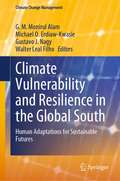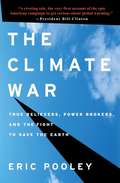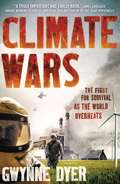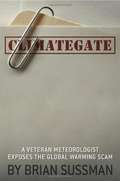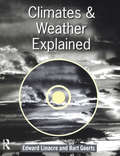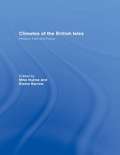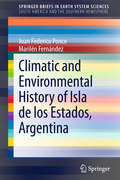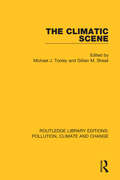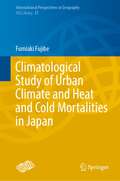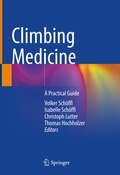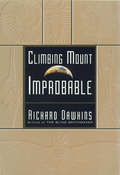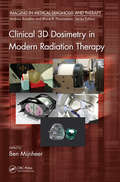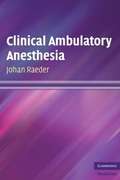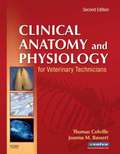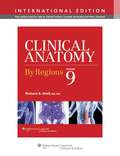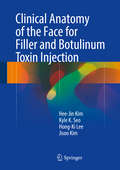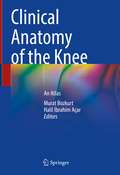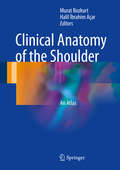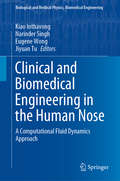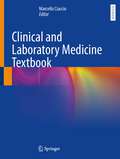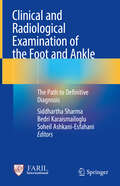- Table View
- List View
Climate Vulnerability and Resilience in the Global South: Human Adaptations for Sustainable Futures (Climate Change Management)
by G. M. Monirul Alam Michael O. Erdiaw-Kwasie Gustavo J. Nagy Walter Leal FilhoThis book provides hands-on conceptual, theoretical, and case study discussions on vulnerability and resilience in the global south. This book covers the core of adaptation strategies in developing countries context in an easy-to-follow theoretical and empirical examples. This book shares contemporary approaches on vulnerability, adaptation strategies, and resilience, which aim to assist its targeted audience (academics, policymakers, and practitioners) to understand and make informed decisions in a wide variety of real-world resilience situations.
The Climate War: True Believers, Power Brokers, and the Fight to Save the Earth
by Eric PooleyIn The Climate War, Eric Pooley--deputy editor of Bloomberg BusinessWeek--does for global warming what Bob Woodward did for presidents and Lawrence Wright did for terrorists. In this epic tale of an American civil war, Pooley takes us behind the scenes and into the hearts and minds of the most important players in the struggle to cap global warming pollution--a fight in which trillions of dollars and the fate of the planet are at stake. Why has it been so hard for America to come to grips with climate change? Why do so many people believe it isn't really happening? As President Obama's science advisor John Holdren has said, "We're driving in a car with bad brakes in a fog and heading for a cliff. We know for sure that cliff is out there. We just don't know exactly where it is. Prudence would suggest that we should start putting on the brakes." But powerful interests are threatened by the carbon cap that would speed the transition to a clean energy economy, and their agents have worked successfully to deny the problem and delay the solutions. To write this book, Pooley, the former managing editor of Fortune and chief political correspondent for Time, spent three years embedded with an extraordinary cast of characters: from the flamboyant head of one of the nation's largest coal-burning energy companies to the driven environmental leader who made common cause with him, from leading scientists warning of impending catastrophe to professional skeptics disputing almost every aspect of climate science, from radical activists chaining themselves to bulldozers to powerful lobbyists, media gurus, and advisors in Obama's West Wing--and, to top it off, unprecedented access to former Vice President Al Gore and his team of climate activists. Pooley captures the quiet determination and even heroism of climate campaigners who have dedicated their lives to an uphill battle that's still raging today. He asks whether we have what it takes to preserve our planet's habitability, and shows how America's climate war sends shock waves from Bali to Copenhagen. No other reporter enjoys such access to this cast of characters. No other book covers this terrain. From the trenches of a North Carolina power plant to the battlefields of Capitol Hill, Madison Avenue, and Wall Street, The Climate War is the essential read for anyone who wants to understand the players and politics behind the most important issue we face today.
Climate Wars: The Fight for Survival as the World Overheats
by Gwynne DyerWaves of climate refugees. Dozens of failed states. All-out war. From one of the world's great geopolitical analysts comes a terrifying glimpse of the strategic realities of the near future, when climate change drives the world's powers towards the cut-throat politics of survival. Prescient and unflinching, Climate Wars will be one of the most important books of the coming years. Read it and find out what we're heading for.Gwynne Dyer has worked as a freelance journalist, columnist, broadcaster, and is author of several books, including War: The Lethal Custom, Future: Tense, and The Mess They Made.
Climategate: A Veteran Meteorologist Exposes the Global Warming Scam
by Brian SussmanDangerous winds are blowing across America's culture today, creating an atmosphere of extreme anxiety. So why is the government making things worse? Former TV meteorologist turned talk show host Brian Sussman wondered that for years, and a decade's worth of investigation has yielded one of the most shocking stories of our time. In CLIMATEGATE, Sussman uncovers the following: * Communist founders Marx and Engels drafted the inspiration that drives today's environmentalist leaders. * Despite rigorous government-sponsored efforts to alter the record, past climate was significantly warmer than today. * Though only a minuscule sliver of earth's atmosphere, carbon dioxide is an essential nutrient for life and, when increased, can prove quite beneficial. * Barack Obama's presidency is a dream come true for those seeking to use the environment to destroy the United States. * Global warming is a convenient theory that is allowing venture capitalists, international bankers and multinational corporations to reap billions--and fellow travelers to imagine a one-world government. * Al Gore's Oscar-winning film should be considered a work of fiction. * Government agencies, elitist politicians and environmentalists are working together to block the expansion of both alternative and traditional energy resources. * The United Nation's policies have worked their way directly into U.S. environmental laws. * The recently leaked e-mails from Great Britain's climate center are further confirmation of a years-long, complex cover-up. * Updating the nation's energy grid is designed to bring Big Brother inside our home. In his book, CLIMATEGATE, Sussman combines his keen ability to readily explain complex scientific subjects with his astute political observations, driving home his conviction: the theory of man-made global warming is a fraud and many of the high-profile personalities fronting such claims are charlatans purposed to change society and make loads of cash.
Climates and Weather Explained: An Introduction From A Southern Perspective: Instructor's Resource Pack (includes Students' And Instructors' Cd-rom)
by Bart Geerts Edward LinacreClimates and Weather Explained is a comprehensive introduction to the study of the atmosphere integrating climatology and meteorology. Clear explanations of basic principles, concepts and processes are supported by a wealth of highly informative illustrations and a vast array of case studies demonstrating the relevance of weather and climate to everyday life. Focusing particularly on the Southern hemisphere the authors provide fresh insights into topical environmental concerns from global warming and natural hazards to sustainable global population. The textbook is supplemented by a unique interactive Student CD-ROM containing entirely additional material, for practical work and more advanced study. Closely related to each chapter of the book, the Student CD-ROM features: * Over 170 extra 'Notes', 40 illustrations and tables. * Multiple choice, self-assessment and practical exercises. * Extended glossary and key word searching * Hypertext presentation and extensive cross-referencing * A gallery of meteorological photographs in full colour A special Instructors' Resource Pack is also available containing an additional Instuctors'CD-ROM. For further information visit: website address here
Climates of the British Isles: Present, Past and Future
by Mike Hulme Elaine BarrowOur understanding of climate and its role in human affairs has changed markedly over recent years, as have climate observation systems and modelling capabilities. Reliance on recent weather statistics to provide a guide for future climate is no longer viable. Evidence of human-induced climate change has placed climate high on political and the media agendas. Climates of the British Isles provides a comprehensive account of what we know about climate and changing climates at the end of the twentieth century. Integrating the historical and geographical dimensions of climate, the crucial link between past and future climatic conditions is examined through the geographical lens of the British Isles. Climates of past ages are reconstructed and full descriptions of present climate are illustrated by a wealth of graphs, maps and images. Important climate data sets are provided. Marking the twenty-fifth anniversary of the internationally acclaimed Climatic Research Unit, this book distils much of the leading research of present and recent members of the unit and presents an authoritative, accessible view of climatic change and prospects for the next millenium and beyond.
Climatic and Environmental History of Isla de los Estados, Argentina (SpringerBriefs in Earth System Sciences #0)
by Juan Federico Ponce Marilén FernándezThis book is the result of ten years' of scientific research carried out by the authors on Isla de los Estados. The research includes their doctoral thesis and many published scientific papers related to the island. The book is divided into two principal parts. The first part covers different social and natural aspects of this remote island and includes chapters on the scientific and historical background, physiography with topographical and hydrographical descriptions, climate and oceanographic circulation, vegetation and geology (including stratigraphy, structural geology and geological history). The second part comprises a reconstruction of the paleoenvironmental, paleoclimatic and paleogeographic history of the island from the Last Glacial Maximum to the present, correlating with other paleoecological records from the southern part of Isla Grande de Tierra del Fuego and Patagonia. This second part also includes a geomorphological chapter with a characterization of the principal erosive glacial landforms on Isla de los Estados constructed by means of morphometric analysis, inventories, maps, paleogeographic and glacial models, and a paleoecological chapter evaluating the palaeoenvironment and palaeoclimatic conditions that prevailed during the Late Pleistocene-Holocene times based on pollen and diatom analysis from three 14C-dated peat bogs and lakes. Finally, the book concludes with a review of the island's archaeology and the relationship between the palaeoenvironmental history and human occupation of this island.
The Climatic Scene
by Michael J. Tooley Gillian M. SheailOriginally published in 1985, this volume of essays was compiled in honour of Gordon Manley, a major and distinctive twentieth-century figure in climatology. The range and scope of the topics covered reflect the eclectic interests of Manley, whose orientation was always towards the importance of climate and its impact on mankind. The state of the art of climatic change is considered at different scales by the contributors: from instrumental records on a local scale from Durham and Manchester to discussions on the regional and continental scale. Methodological problems relating to climatic change are treated. The effects of climate and climatic change on plant distribution, disease vectors and agricultural pests are also considered.
Climatological Study of Urban Climate and Heat and Cold Mortalities in Japan (International Perspectives in Geography #21)
by Fumiaki FujibeThis book describes observed features of urban climate and its long-term variations as well as the relationship of climate to heat stroke in Japan, based on observational data and statistical analyses. Consisting of three parts, the book is a valuable resource for researchers and professionals involved with these topics. Part 1 focuses on urban climate. The basic characteristics of heat islands are reviewed, and long-term urban warming is described with a focus on the distinction from global warming. The influence of microscale environmental changes on the observed temperature is also presented, as well as changes in wind and precipitation in urban areas. They deepen our understanding of the features and mechanisms of urban heat islands and their long-term changes. Part 2 describes the climatological features of heat stroke mortality, which has become a major social problem in Japan, using mortality statistics and meteorological data. The spatial and temporal variations of heat stroke mortality are analyzed quantitatively on various spatial and temporal scales. In addition, the number of ambulance transports is examined as another measure of heat stroke casualty. The results provide insight into the climatological factors related to heat stroke mortality and contribute to the implementation of preventive measures. The climatology of deaths from extreme cold is also presented. For supplementary information, an overview of the geography, climate, and meteorological data of Japan is presented in Part 3.
Climatology of West Africa
by Derek F. Hayward Julius S. OguntoyinboOriginally published in 1987, this book brings together information previously buried in specialist sources and makes it available to the student in a non-technical and well-illustrated synthesis. It builds a clear and detailed picture of the climates of West Africa, describing and explaining them and showing how crucial this understanding is to everyday life. The climate’s relevance to water resources, agriculture, health and industry is systematically considered.
Climbing Medicine: A Practical Guide
by Volker Schöffl Isabelle Schöffl Christoph Lutter Thomas HochholzerThis book comprehensively discusses the medical aspects of sports climbing, a still young but emerging sport, which will be one of the disciplines at the Tokyo Olympics. Its rapid development from niche to popular sport has been accompanied by an increase in the number of climbing-sports-specific injuries and has attracted growing interest within the sports medicine community. Gathering expertise from around the globe, the book covers all aspects related to this discipline – from physiology, biomechanics and anatomy through upper and lower extremity injuries to cardiology, gynecology, pediatric and adolescent conditions. Following a coherent structure, each chapter equips readers with evidence-based diagnostic and therapeutic guidelines. Enriched by a wealth of pictures, this manual offers a timely and up-to-date resource for sports physicians, orthopedic surgeons and traumatologists, as well as trainers, physiotherapists and other health professionals involved in climbing.
Climbing Mount Improbable
by Richard DawkinsIt's a treat when a scientist is able to convey the significance of a subject while at the same time commanding a reader's attention with intelligence, wit, and style. Dawkins (Chair, Public Understanding of Science, Oxford U.) manages to make the evolutionary design of animal and insect life both a source of serious biological inquiry and one of miraculous discovery. He portrays the silky worlds of spiders, how wings sprouted on previously flightless animals, the evolution of the human eye (no less than 40 leaps), and details how DNA paves the way for change across the whole spectrum of flying, swimming, and walking creatures. Annotation c. by Book News, Inc., Portland, Or.
Climbing Mount Improbable
by Lalla Ward Richard DawkinsA brilliant book celebrating improbability as the engine that drives life, by the acclaimed author of The Selfish Gene and The Blind Watchmaker. The human eye is so complex and works so precisely that surely, one might believe, its current shape and function must be the product of design. How could such an intricate object have come about by chance? Tackling this subject--in writing that the New York Times called "a masterpiece"--Richard Dawkins builds a carefully reasoned and lovingly illustrated argument for evolutionary adaptation as the mechanism for life on earth. The metaphor of Mount Improbable represents the combination of perfection and improbability that is epitomized in the seemingly "designed" complexity of living things. Dawkins skillfully guides the reader on a breathtaking journey through the mountain's passes and up its many peaks to demonstrate that following the improbable path to perfection takes time. Evocative illustrations accompany Dawkins's eloquent descriptions of extraordinary adaptations such as the teeming populations of figs, the intricate silken world of spiders, and the evolution of wings on the bodies of flightless animals. And through it all runs the thread of DNA, the molecule of life, responsible for its own destiny on an unending pilgrimage through time. Climbing Mount Improbable is a book of great impact and skill, written by the most prominent Darwinian of our age.
Clinical 3D Dosimetry in Modern Radiation Therapy (Imaging in Medical Diagnosis and Therapy)
by Ben MijnheerThis book provides a first comprehensive summary of the basic principles, instrumentation, methods, and clinical applications of three-dimensional dosimetry in modern radiation therapy treatment. The presentation reflects the major growth in the field as a result of the widespread use of more sophisticated radiotherapy approaches such as intensity-modulated radiation therapy and proton therapy, which require new 3D dosimetric techniques to determine very accurately the dose distribution. It is intended as an essential guide for those involved in the design and implementation of new treatment technology and its application in advanced radiation therapy, and will enable these readers to select the most suitable equipment and methods for their application. Chapters include numerical data, examples, and case studies.
Clinical Ambulatory Anesthesia
by Johan RaederAmbulatory care can be a challenging setting in which to provide anesthesia - not all patients are suitable for rapid discharge post-operatively and opinions differ as to which types of surgery should be performed as day cases. This comprehensive guide delivers up-to-date, evidence-based advice on how to provide optimal anesthesia care for ambulatory surgery. Written by a leading clinical anesthesiologist, it provides clear guidance about how to handle particular patients in particular situations. The evidence and scientific knowledge for each issue are presented with reference to major studies and review papers, followed by practical advice based on the author's continuous clinical and scientific experience over 30 years. Topics include planning, equipping and staffing ambulatory units, pharmacology, basic concepts of ambulatory care, pre- and post-operative issues and current controversies. Clinical Ambulatory Anesthesia is essential reading for the clinical, postgraduate anesthesiologist as well as nurse anesthetists involved with ambulatory care.
Clinical Anatomy and Physiology for Veterinary Technicians (2nd Edition)
by Joanna M. Bassert Thomas ColvilleExamine the diverse ways animal bodies function at both the systemic and cellular levels with this vital resource. It brings you clear coverage essential to understanding the clinical relevance of anatomical and physiological principles. Fully updated and written by respected veterinary technician educators, this popular textbook is the practical, comprehensive foundation for your success in veterinary technology. Clinical application boxes help you sharpen your skills and apply principles to practice. Test Yourself boxes throughout chapters emphasize important study points. An extensive glossary provides quick reference to hundreds of important terms and definitions. Over 300 new illustrations help you identify structures with rich, realistic clarity. A NEW full color format visually enhances your understanding of anatomic and physiologic concepts. Four NEW chapters give you the latest insight on the chemical basis of life, nutrition and metabolism, pregnancy, development, and lactation, and reptile and amphibian anatomy and physiology. A revised chapter on the cardiovascular system helps you most effectively comprehend the complex functions of the heart and blood vessels.
Clinical Anatomy by Regions
by Richard S. SnellThis book provides medical students, dental students, allied health students, and nursing students with a basic knowl¬edge of anatomy that is clinically relevant.
Clinical Anatomy of the Face for Filler and Botulinum Toxin Injection
by Hee-Jin Kim Jisoo Kim Kyle K. Seo Hong-Ki LeeThis book, containing more than 200 cadaveric photos and 200 illustrations, aims to familiarize physicians practicing botulinum toxin type A (BoT-A) and filler injection with the anatomy of the facial mimetic muscles, vessels, and soft tissues in order to enable them to achieve optimum cosmetic results while avoiding possible adverse events. Anatomic considerations of importance when administering BoT-A and fillers are identified and in addition invaluable clinical guidelines are provided, highlighting, for example, the preferred injection points for BoT-A and the adequate depth of filler injection. Unique insights are also offered into the differences between Asians and Caucasians with regard to relevant anatomy. The contributing authors include an anatomist who offers distinctive anatomic perspectives on BoT-A and filler treatments and three expert physicians from different specialties, namely a dermatologist, a plastic surgeon, and a cosmetic physician, who share insights gained during extensive clinical experience in the use of BoT-A and fillers.
Clinical Anatomy of the Knee: An Atlas
by Murat Bozkurt Halil İbrahim AçarThis book provides detailed information on functional anatomy, physical examination, and clinical radiology of the knee with a view to enabling the clinician to identify the most suitable treatment approach to different knee joint pathologies. In addition, the arthroscopic treatment techniques most frequently employed in patients with these conditions are described, with presentation of numerous arthroscopic images detailing characteristic findings. Knee joint pathologies today represent a significant challenge owing to the complexity of the injuries suffered, rising activity levels, and high patient expectations. A proper physical examination plays an important role in diagnosis. The surgeon who has the opportunity to conduct a clinical evaluation must fully understand the role of radiological evaluations, and assessment by a radiology expert is also necessary. In all cases, knowledge of the normal anatomy and its correlation with clinical and radiological findings is fundamental to correct diagnosis and treatment selection. Surgeons and trainees with an interest in knee joint pathologies will find this book to be an excellent, richly illustrated educational guide to the subject.
Clinical Anatomy of the Shoulder: An Atlas
by Murat Bozkurt Halil İbrahim AçarThis book provides detailed information on functional anatomy, physical examination, and clinical radiology of the shoulder with a view to enabling the clinician to identify the most suitable treatment approach to different shoulder joint pathologies. In addition, it describes the arthroscopic treatment techniques most frequently employed in patients with these conditions and presents numerous arthroscopic images detailing characteristic findings. The shoulder is widely regarded as the most complex joint in the human body, displaying the widest range of motion. Knowledge of normal and pathological anatomy, ability to perform a proper physical examination, and appropriate selection of imaging modalities and interpretation of imaging appearances, often in close collaboration with an imaging expert, are all vital for correct diagnosis and choice of treatment approach. Surgeons and trainees will find this richly illustrated book to be an excellent educational guide and an instructive source of stepwise guidance from clinical presentation to achievement of desired treatment outcomes.
Clinical and Biomedical Engineering in the Human Nose: A Computational Fluid Dynamics Approach (Biological and Medical Physics, Biomedical Engineering)
by Kiao Inthavong Narinder Singh Eugene Wong Jiyuan TuThis book explores computational fluid dynamics in the context of the human nose, allowing readers to gain a better understanding of its anatomy and physiology and integrates recent advances in clinical rhinology, otolaryngology and respiratory physiology research. It focuses on advanced research topics, such as virtual surgery, AI-assisted clinical applications and therapy, as well as the latest computational modeling techniques, controversies, challenges and future directions in simulation using CFD software. Presenting perspectives and insights from computational experts and clinical specialists (ENT) combined with technical details of the computational modeling techniques from engineers, this unique reference book will give direction to and inspire future research in this emerging field.
Clinical and Laboratory Medicine Textbook
by Marcello CiaccioThis textbook describes several diseases and clinical conditions, from physiopathological mechanisms to main clinical pictures, highlighting the importance of laboratory medicine, with the aim to provide the necessary tools for guiding correct laboratory findings interpretation. Indeed, it is now widely recognized that laboratory medicine has a pivotal role in clinical medicine, significantly influencing clinical decisions. Thus, it is crucial to understand and use laboratory data appropriately. This book has the great advantage of describing each topic exhaustively in order to facilitate its understanding. Specifically, it describes both diseases with a high incidence in the population, such as Diabetes Mellitus, Cardiovascular Diseases, Dyslipidemias, and Autoimmune Diseases, as well as rare diseases, such as Hereditary Metabolic Diseases. In addition, unusual topics are treated, such as Clinical Biochemistry of the Mind, as well as hot topics, such as Biological Drugs, Biobanks, Health Technology Assessment, and Omics Sciences. Finally, the book includes a chapter on the new health emergency, the SARS-CoV-2 pandemic. Two appendices are provided at the end of the book: a table summarizing the reference range and decisional cut-off for the main laboratory parameters and instructions on performing a venous blood sample. The book will be an invaluable tool for medical and biomedical students, as well as for practitioners.
Clinical and Neuropsychological Aspects of Closed Head Injury (Brain, Behaviour and Cognition)
by Dr J RichardsonIn all industrialised countries, closed head injuries are responsible for vast numbers of hospital admissions and days of work lost. For instance, about 120,000 patients are admitted to hospital in the United Kingdom each year with a diagnosis that reflects closed head injury. Such injuries are a major cause of deaths following accidents, especially those that involve children and young people, and they are also a major cause of handicap and morbidity among the survivors. This clinical condition is intrinsically a neurological one, but its proper evaluation demands an understanding of the associated psychology and psychopathology. At the same time, a major neurological condition with such a high level of incidence ought to be extremely informative about the functioning of the human brain and hence provide a major focus for neuropsychological investigation. In this book, the author seeks to integrate these two different perspectives by reviewing the clinical and neuropsychological aspects of closed head injury in a manner that is equally intelligible to researchers interested in the effects of brain damage upon human behaviour and to practitioners who are responsible for the assessment, management and rehabilitation of head-injured patients.This is the second edition of a book which was first published in 1990, and which has been extensively revised in the light of the subsequent research in the field. The book begins by considering the epidemiology, causes and structural neuropathology of closed head injury. It then considers the impact of closed head injury on memory, cognition, language, communication, personality and social behaviour. Finally it outlines the outcome, the mechanisms of recovery and the prospects for rehabilitation.
Clinical and Preclinical Models for Maximizing Healthspan: Methods and Protocols (Methods in Molecular Biology #2138)
by Paul C. GuestThis book presents a series of protocols in multiple disease areas affected by the aging process along with several methods which have shown progress in nutrient- or intervention-based approaches to maximize the healthspan. Of interest to researchers in the areas of chronic disease, gerontology, physical exercise, and nutrition as well as to clinical scientists, physicians, and pharmacologists, this volume also provides important information on disease mechanisms and novel drug targets as each protocol will be presented in the context of specific chronic diseases or different therapeutic areas. Written for the highly successful Methods in Molecular Biology series format, chapters include introductions to their respective topics, lists of the necessary materials and reagents, step-by-step, readily reproducible laboratory protocols, and tips on troubleshooting and avoiding known pitfalls. Authoritative and practical, Clinical and Preclinical Models for Maximizing Healthspan: Methods and Protocols is an ideal guide for preclinical and clinical researchers working toward the discoveries needed to lead to a world society in which individuals are not only living longer lives but more productive and healthier ones.
Clinical and Radiological Examination of the Foot and Ankle: The Path to Definitive Diagnosis
by Siddhartha Sharma Bedri Karaismailoglu Soheil Ashkani-EsfahaniThe foot and ankle are among the most complicated anatomical regions of the human body, making their examination challenging. The perfect equilibrium between bones, tendons, ligaments, and other anatomical structures can be disturbed by pathological processes leading to complex disorders. The path to definitive diagnosis passes through a comprehensive clinical and radiological examination. However, the sources focusing on examining the foot and ankle pathologies are limited. Hence, this book aims to cover all aspects of clinical and radiological examination of the foot and ankle, including basics, general approach, and a closer look at the different foot and ankle pathologies. It will include the most up-to-date diagnostic methods, special tests, and radiological evaluations and give clues about the various situations that should be considered before going into surgery. With a broad range of clinical and radiological images, the path to diagnosis gets simpler! Chapters provide a systematic approach to evaluating various foot and ankle problems such as instabilities, tendinopathies, deformities, trauma, neuropathies, cartilage disorders, impingement, heel pain, etc. Moreover, it includes a chapter emphasizing the emerging technologies used for more precise clinical evaluation.This book will aid foot & ankle surgeons, podiatrists, and general orthopedic surgeons in understanding clinical and radiological examination for improved diagnosis, as well as fellows, residents, and medical students interested in foot and ankle pathologies.
